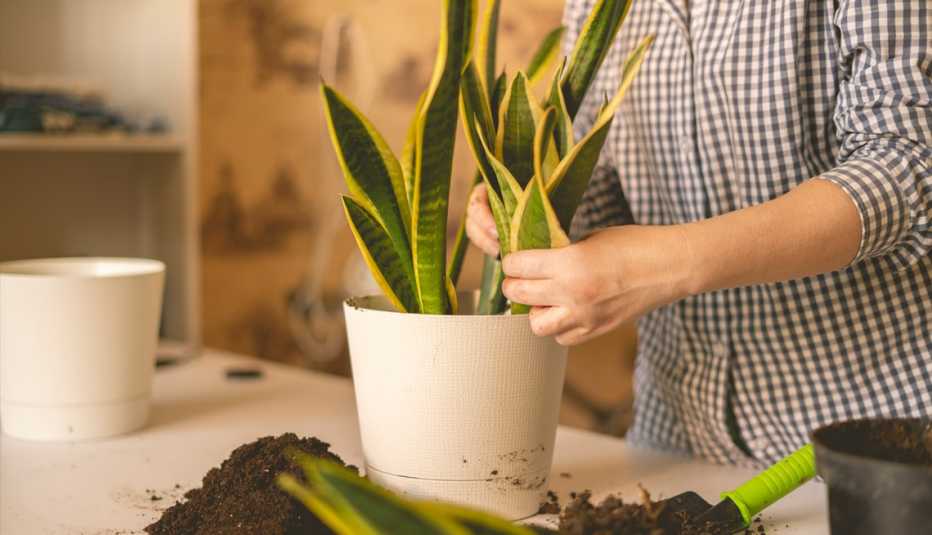AARP Hearing Center
Houseplants are family to Danielle Jeanloz.
Jeanloz, 68, and her husband have almost two dozen indoor plants in their home in Chatham, Massachusetts, as well as a dozen or so in their antique shop.
“They have a lot of history and personality to them,” Jeanloz says of her plants, which include a 7-foot ficus tree. “The ones that are given to us have memories of the person who’s given it to us. … I’m proud to say that we have a couple of plants we’ve had for more than 40 years.”
Although Jeanloz has been growing plants indoors for years, she’s part of a hot trend. Even before COVID-19, houseplant sales had climbed 50 percent in the three years leading up to 2019, according to the National Gardening Association. Then came the pandemic, with its focus on home life, and suddenly it seemed that plant advice and hacks were all over Instagram, TikTok and other sites.
“With COVID and so many lockdowns, people have been stuck at home. So they’re looking around their space and feeling like, ah, it doesn’t feel that good in here. I’m here all the time now,” says Danae Horst, owner of Folia Collective, a plant shop in Los Angeles. “So a lot of people have really filled their home with plants.”
Houseplants are an accessible and inexpensive hobby, even if you have trouble keeping plants alive for 40 days, let alone 40 years. Just follow some basic rules, experts say.
- Assess your environment. Not all houseplants love the same conditions. Before you buy a plant, consider your home’s light exposure, humidity and temperature — and your lifestyle. For example, do you need something low maintenance because you’re away from home a lot? “Really making sure you’re choosing something that matches your space and your lifestyle — that’s going to set you up for success better than just choosing the plant from the list that someone said was easy,” Horst says.
- Water wisely. Jeanloz admits she overwaters. Her solution was to buy a water meter that tracks moisture in the soil. Candice Hart, a state master gardener specialist with the University of Illinois Extension, has another option: Stick your finger in the soil. When the soil is dry, really saturate the plant and let it drain rather than lightly watering the top layer of soil.
- Follow the instructions. The most common mistake is not researching a plant or ignoring care suggestions that come with it, says Mignon Hemsley, who, with Danuelle Doswell, owns Grounded, a virtual plant store based in Washington, D.C. Need help? Check back with the store or garden center, reach out to your state extension service, research experts on TikTok, Instagram and YouTube, or follow an indoor-plant Facebook or Reddit group.
- Learn from failure. When things don’t work out, let it go. Sacrifice your plant to compost and move on. “I mean, obviously, it can be costly if you’re buying a lot of plants. But I’ve certainly learned a lot over the years by killing a lot of things,” Hart says. “There’s always those couple of plants that I just keep trying over and over again and getting better, a little bit better.”
If you’re ready to take the plunge, here’s a list of houseplants these experts say are good for novices.
1. African violets


These traditional houseplants originated in the coastal woods of east Africa, according to the University of Georgia Extension. Though they have a reputation for being old-fashioned or fussy, they provide months of color and often live happily on a windowsill with bright light. Be wary of direct sun since it can scorch the leaves, and use room-temperature water to avoid spotting them. Violets like well-drained soil and a shot of 20-20-20 fertilizer every four to six weeks. Be careful not to overwater. The African Violet Society of America recommends waiting until the top half-inch of soil feels dry and not letting the pots sit in water.
2. ZZ plant


The initials stand for Zamioculcas zamiifolia. These tough, vertical plants require little light and can tolerate being dry because the rhizomes in their root system hold water. The raven variety has leaves that are almost black.
3. Golden pothos


This trailing plant will give you hints about what it needs, Doswell says. When the leaves point up, they are well hydrated; when they start to droop, they need water. Water too much, and they turn yellow.
4. Snake plant


“Super-duper low maintenance,” Hemsley says. Sometimes called mother-in-law’s tongue, it’s a vertical slow grower that’s very adaptable and does well in low light.
5. Jade plant


Part of the succulent family, these plants can live for generations. They like bright, indirect light but can adapt to low light. The more light available, the bigger they get.
6. Peace lily


This is a more challenging beginner-friendly plant, Hemsley says, and can be a bit of a diva — drooping when it’s dry, for example. But patience will be rewarded with striking green foliage and white blooms.






































































